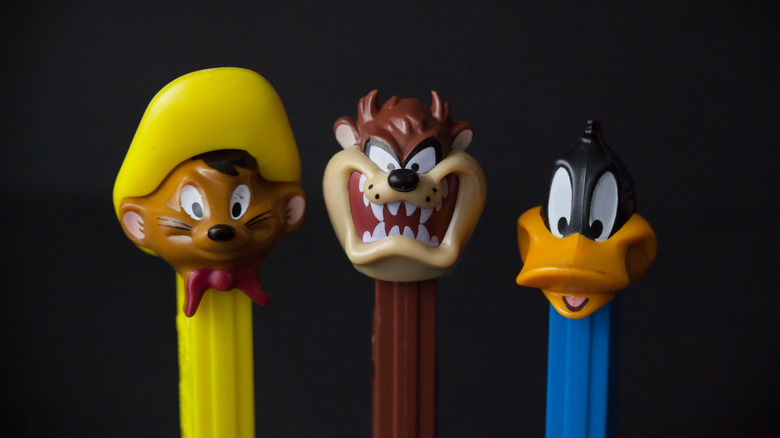PEZ Was Created For A Pretty Adult Reason
At this point, most of us think of PEZ dispensers as more of a decorative element to a shelf than we do actual candy holders, but you can't forget that those spring-loaded knickknacks do serve a purpose. Push that top back, and the pressed sugar candy comes right out the neck, ready to pop into your mouth on a moment's notice. The candy, in terms of modern confections, has always resembled pills to me, and that's not by coincidence. It's because they're manufactured by a pharmaceutical-style tablet press.
That nifty press applies 3,000 pounds of pressure on a mix of sugar, corn syrup, flavoring, and other ingredients to create each candy tablet. The dry cold-press method is how pharmaceutical tablets are made, as well, and the reason why PEZ was invented in the first place is actually closer to a medical purpose than you might have imagined: It was developed as a smoking cessation aid.
PEZ was invented in 1927 by Austrian confectioner Eduard Haas III, who was a staunch anti-smoking advocate. The three letters in its name are pulled from the German word "pfefferminze," which means "peppermint" and also happens to be the candy's original flavor. In addition to helping curb smoking, Haas hoped PEZ would mitigate habits such as overeating as well.
PEZ eventually shifted its marketing toward children
PEZ's tablet format came about because any hard candy process involving boiling peppermint oil at the time would end up evaporating its flavor, and Eduard Haas III found that the cold-press manufacturing process was able to preserve the taste. The candy itself was originally round in shape and came in foil paper wrapping or tins. In 1947, Haas and his team developed a PEZ dispenser that resembled a cigarette lighter, which served one piece of candy at a time, originally called a "PEZ Box."
The eventual leap from cigarette association to a popular children's candy seems like an unlikely one, but when PEZ was first exported to America from Austria in 1952, Haas found that its stateside sales were initially underwhelming. Its decidedly adult-themed marketing up until then included use of attractive "Pez Girl" imagery, but Haas realized that children were more interested in the candy than adults were. As part of a rehashed marketing strategy aimed toward children, those now-famous toy-topped dispensers were introduced in 1955, with Popeye, a space trooper, and Santa Claus thought to have been among the first heads adorning them.
After that, the dispensers and the candy became a part of pop culture history, with PEZ's connection to smoking having faded into the background. So if you're like me and have loosely associated PEZ's shape and candy format with something vaguely medicine-related, just know that your hunch was actually not that far off.

